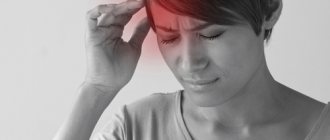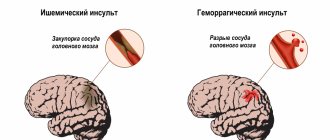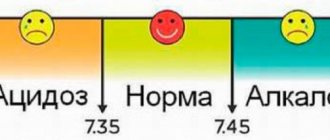Hypertension - causes and mechanism of development
Hypertension is a chronic disease in which there is a frequent increase in blood pressure. If normally it is 120/80 mm. rt. Art., then at 140/90 mm. rt. Art. The initial stage of the disease has already been diagnosed. In some patients, only the systolic (upper) pressure increases, but the lower (diastolic) pressure may also increase along with it. The diagnosis is made based on the results of measuring blood pressure in different physiological states: during rest and after exercise.
Blood pressure increases due to dysregulation, vascular spasms and other factors. In most patients, hypertension is primary - it manifests itself as an independent disease, and a hereditary predisposition can also be observed. In other cases, the disease is caused by long-term use of certain groups of drugs, including hormonal drugs, kidney disease and metabolic disorders. Thus, secondary (symptomatic) hypertension is diagnosed, which also often causes headaches and high blood pressure.
Doctors identify risk factors that can provoke attacks of hypertension, as well as aggravate the course of the disease in the early stages. These include:
- overweight – up to 85% of patients diagnosed with chronic hypertension suffer from obesity;
- smoking - this bad habit reduces the ability of blood vessels to respond to changes in blood pressure, and also provokes ischemia (oxygen starvation) of the myocardium;
- insufficient physical activity, sedentary lifestyle, working behind a monitor;
- stressful situations that activate the sympathetic nervous system and lead to a persistent increase in blood pressure;
- patient's age.
According to statistics, in young people hypertension is secondary and is associated with a person’s lifestyle. High blood pressure and headaches are often triggered by bad habits, stress and poor diet. At the age of 40 years and older, sclerotization of the arteries is diagnosed - a decrease in their strength and elasticity as a result of the growth of connective tissue. This process is irreversible, but can be reversed by taking medications, adequate exercise and a therapeutic diet.
How often should you check your blood pressure readings?
Blood pressure is usually measured when visiting a doctor (for example, a therapist). There is no need to specifically visit a specialist for this; it is enough to ensure that the pressure is measured at least once every 2 to 5 years, starting from the age of 18 (with normal blood pressure and no increased risk of cardiovascular diseases).
People over 40 years of age, and people 18–40 years of age at risk of high blood pressure, should have their blood pressure checked at a healthcare facility at least once a year. If a diagnosis of arterial hypertension has been established or a person has other risk factors for developing cardiovascular diseases, it is recommended to measure blood pressure more often and not neglect monitoring at home. Your doctor will help you choose a device for measuring blood pressure (tonometer).
For children 3 years of age and older, blood pressure is measured regularly during annual routine examinations.
Caution: The American Heart Association does not recommend the use of wrist- or finger-worn blood pressure monitors, which are less accurate.
If recommended, measure blood pressure at home twice a day on the left and right arm: in the morning before breakfast (but not immediately after waking up) and before taking any medications, and in the evening, preferably at the same time. In each case, you need to measure the pressure 2-3 times (at short intervals, 1-3 minutes) for a confident, accurate result. 30 minutes before, do not smoke, do not eat, do not drink coffee (and alcohol), do not exercise, and empty your bladder. During the measurement, you must sit in a comfortable position, leaning back in a chair or armchair, do not cross your legs and ankles, and do not talk. The arm on which the cuff is worn must be freed from clothing and held at heart level; it is most convenient to place it on a table or armrest of a chair. Don't forget to write down your measurement results.
Features of headaches in hypertension
Pressure headaches are the result of impaired vascular ability to adapt to external and internal changes. Blood presses on the inner walls of blood vessels, irritating the receptors. These signals travel to the brain, where they are converted and cause pain. In advanced stages of the disease, this condition is accompanied by increased fluid pressure inside the skull, which also causes severe headaches.
Chronic hypertension manifests itself as alternating periods of rest and increased blood pressure. During attacks, the patient has a very headache, the pressure in the arteries rises sharply. This can be caused by a number of factors:
- physical or mental fatigue - in this case, to normalize blood pressure indicators, it is enough to pay attention to proper rest;
- changes in weather conditions - a sharp increase in atmospheric pressure often provokes attacks of hypertension, which can be eliminated with rest and medications;
- abnormal physical activity – causes acceleration of blood flow and heart rate, which is dangerous if the elasticity of the blood vessels is insufficient;
- pregnancy – hormonal changes cause attacks of hypertension;
- unhealthy diet – consuming excess amounts of salt and spices leads to impaired removal of fluid from the body, swelling and an increase in the volume of circulating blood.
Headache with high blood pressure has its own characteristics. It can be caused by various reasons, so it is usually classified into vascular, liquor, ischemic and neuralgic. In most patients, it spreads to the temples and back of the head. It is sharp, pressing, and leads to impaired concentration. With a sharp increase in pressure, hearing and vision deterioration and fainting may occur.
Vascular pain
The main cause of vascular syndrome is a violation of the outflow of fluid from the brain. Arteries and veins fill with blood, tissue swelling is observed. This leads to irritation of nerve receptors and an increase in pain. The pain in the head with pressure is pressing, the pulsation of blood vessels is felt. It intensifies if you lower your head down, as well as with sudden movements, coughing and sneezing.
Liquor syndrome
Another reason why headaches occur with pressure is a violation of the movement of cerebrospinal fluid. This is a special fluid that is found in the brain and spinal cord. It performs a shock-absorbing function, protects soft tissues from compression and regulates pressure in the skull. Normally, it circulates constantly, but in case of vascular pathologies, heart disease and chronic hypertension, it is retained in the brain. This process is accompanied by aching, bursting pain, which intensifies during sudden movements of the head. The process is dangerous because the cerebrospinal fluid also contains nutrients for nerve cells. If fluid circulation is not stimulated, this can lead to cerebral ischemia and trigger a stroke.
Ischemic pain syndrome
The cause of headaches and pressure can be spasm of blood vessels. This leads to insufficient oxygen and nutrients reaching certain areas of the brain. The patient also experiences hearing and vision impairment, dizziness, a sharp increase in blood pressure and weakness. Attacks are relieved by using antispasmodics; rest and means to normalize the functioning of the nervous system are also useful.
Neuralgic pain
Increased pressure inside the skull affects all nerve structures. Excess cerebrospinal fluid leads to compression of the trigeminal nerve, which is responsible for the innervation of the skin and muscles of the face. The pain in this case is sharp, throbbing, concentrated in the facial part. It worsens during movement, bending and turning the head.
Additional symptoms
It is important for a patient with chronic hypertension to know how a headache occurs with high blood pressure. It has several features that indicate a simultaneous increase in blood pressure:
- headache spreads to the back of the head and temporal parts of the head;
- the nature of the pain is pressing, there is a feeling of expansion of the contents of the skull;
- filling of blood vessels leads to redness of the skin and mucous membranes, minor hemorrhages are possible due to damage to the walls of the capillaries;
- ringing or noise in the ears is a typical sign of high blood pressure;
- blurred vision, the appearance of various hallucinations in the form of black dots or circles before the eyes;
- weakness, fatigue, decreased performance;
- dizziness, nausea;
- a sharp increase in blood pressure is the cause of fainting.
If your head starts to hurt severely, you need to measure your blood pressure. The procedure can be carried out independently, using a tonometer. This device should be in every home medicine cabinet, even if there are no patients with chronic hypertension in the family. Headaches go away after blood flow is restored and pressure is normalized, including with individually selected medications.
What to do?
If your blood pressure has increased, a headache or other accompanying symptoms have appeared, it is highly likely that this is a hypertensive crisis. The sequence of actions should be as follows:
- Relief of crisis and normalization of blood pressure.
- Finding out the cause of the crisis.
- Taking measures to prevent crises, because each of them can result in acute coronary syndrome, cerebral hemorrhage, aortic dissection or other serious complication, the number of which is in the dozens.
All of the above should be done by the doctor, not the patient. At the first stage, the doctor stops the attack. The rate of decrease in blood pressure should not exceed 25% in 2 hours. Target blood pressure should be achieved no earlier than a day or two after the crisis. This effect is achieved by a combination of fast-acting drugs and long-acting drugs.
The doctor’s further task is to find out the cause of the crisis and eliminate it. The patient requires ongoing antihypertensive therapy if his blood pressure is higher than normal.
First aid for high blood pressure
If you don't have medications on hand, and before consulting your doctor, there are a few steps you can take to lower your blood pressure. Also, these methods help relieve vascular spasm and restore cerebral blood flow. Doctors at the Clinical Brain Institute recommend following a number of simple steps:
- provide the patient with rest in a cool room;
- sufficient oxygen access - simple ventilation often helps to relieve pain, nausea and dizziness;
- massage of the neck and head is a way to relax the muscles and reduce their pressure on the blood vessels; you can do it yourself;
- a cool compress applied to the temples and soles of the feet.
Doctors advise limiting yourself to only those drugs that are indicated in the prescription. If they do not help, you should contact for a second consultation and adjust the list of medications. In addition, the patient should not independently increase the dosage of drugs to increase blood pressure and take additional drugs for a quick effect.
High blood pressure danger
A hypertensive crisis (high blood pressure or BP) is a condition when blood pressure rises quickly and sharply, with readings of 180/120 or higher. The consequences of uncontrolled blood pressure in this range can be serious and include:
- stroke;
- loss of consciousness with dangerous injuries;
- memory loss;
- acute cardiovascular diseases;
- eye damage and visual disturbances;
- loss of kidney function;
- aortic dissection;
- angina pectoris (unstable chest pain);
- Pulmonary edema (fluid reserve in the lungs).
If you have been diagnosed with high blood pressure, monitor your readings and take your medications. During an emergency, having the notes with you can provide valuable information to the medical team providing treatment.
Contraindications for hypertension
Headache with hypertension has its own characteristics. To get rid of it, it is necessary to relax the vascular walls and cause their expansion, as well as stimulate the outflow of excess fluid. At home, it is prohibited to take the following measures to treat pain caused by increased blood pressure:
- be in a stuffy room;
- take a hot bath, visit a bathhouse or sauna;
- drink coffee or natural strong tea, which also contains high concentrations of caffeine;
- buy or drink alcoholic beverages.
It is important to understand that treatment tactics and first aid differ for high and low blood pressure. Before taking medications, you must use a tonometer, and then periodically monitor the readings. It is especially important to monitor them in case of vegetative-vascular dystonia, a chronic disease in which blood pressure periodically changes both up and down.
Normal blood pressure: what is upper and lower pressure
Blood pressure is measured using a device called a tonometer. A cuff (a wide band that compresses) is placed on the arm. This cuff is attached to a device that measures the pressure inside your arteries. When you turn on the blood pressure monitor, the cuff tightens and then slowly relaxes again. It's quick and painless. Eventually, the device will show your blood pressure.
Blood pressure is measured in millimeters of mercury. The blood pressure reading consists of two numbers, for example 120/75. The first (top) number is the pressure when the heart beats (systolic pressure). The second (lower) number is when the heart relaxes (diastolic pressure).
High blood pressure usually does not cause symptoms. The only way to know if your blood pressure is elevated is to measure it. For example, a value of 110/70 is within the normal range for blood pressure; 126/72 – high blood pressure; value 135/85 – stage 1 hypertension (mild), etc. (see table).
Diagnostic methods
You can diagnose hypertension at home, if you have a working tonometer. However, the disease may have its own characteristics and occurs for various reasons. It is important to undergo a full examination to determine why your blood pressure is rising. This information will help you choose an effective treatment regimen, as well as prevent further development of the disease. After examining and measuring blood pressure, the doctor may prescribe the following diagnostic methods:
- MRI of the head is one of the most effective methods, which is used when there is a suspicion of increased intracranial pressure, the presence of neoplasms and foci of ischemia;
- Dopplerography of the vessels of the neck and head is an informative technique that involves studying blood flow using a contrast agent;
- clinical and biochemical blood tests - allow you to evaluate the chemical composition of the fluid and determine protein metabolism disorders;
- X-ray of the cervical spine - spondylosis, osteochondrosis and other diseases that lead to compression of blood vessels and increased blood pressure in them will be visible in the pictures.
The Clinical Brain Institute has all the conditions to undergo a complete examination for headaches and high blood pressure. To confirm the diagnosis, the patient will be offered consultations with specialists of a narrow and broad profile. This will allow you to comprehensively consider the disease and select treatment that will affect not only the symptoms, but also the cause of the disease.
Treatment methods for hypertension
The main goal of treating hypertension is to reduce the risk of developing the most dangerous complications (stroke, myocardial infarction, chronic renal failure and nephrosclerosis). To this end, measures are being taken to reduce blood pressure to normal levels and reduce the vulnerability of target organs. The patient needs to be prepared that antihypertensive therapy will be carried out for life. The course of treatment at stages II and III of the disease necessarily includes drug therapy. Treatment of stage I hypertension may not require medications, but may be limited only to non-drug therapy methods. In any case, non-drug therapy for hypertension is very important.
A patient with hypertension should regularly measure blood pressure and follow all instructions of the attending physician.
Treatment of headaches with high blood pressure
An acute attack of headache can be relieved with analgesic drugs. These include Citramon, Analgin and other products that are in the simplest home medicine cabinet. However, to control blood pressure levels, an individual treatment regimen is prescribed. It depends on the cause and stage of hypertension, the patient’s age, the presence of concomitant diseases and other factors. It may include drugs from different groups.
- Selective beta blockers are drugs that reduce the heart rate, which leads to a decrease in pressure on the internal walls of blood vessels. This group includes Bisoprolol, Metoprolol and their analogues.
- Calcium channel blockers (Cordafen, Felodipine) are often prescribed for the complex treatment of hypertension because they have no side effects. They prevent the penetration of excess calcium ions into the walls of blood vessels. This causes them to expand and relax, as well as slowing down the rapid heartbeat.
- Medicines from the nitrate group (Nitrong, Kardiket) are used for significant increases in blood pressure. They will help reduce it in the short term, but are not suitable for long-term use.
- Alpha blockers (Phentolamine) are drugs that quickly relieve vascular spasms and restore blood movement through the arteries.
- Diuretics (Furosemide, Lazex) are diuretics. They are suitable for taking in a course and are used in the treatment of chronic hypertension. These drugs stimulate the removal of excess fluid and control the volume of circulating blood.
- Antispasmodics are a group of drugs that quickly relieve vascular spasms. This group includes No-Shpa, Spazmalgon and other drugs that are suitable for eliminating headaches of any origin.
If your blood pressure often rises and your head hurts, this requires complex treatment. Doctors at the Clinical Institute of the Brain will select the optimal regimen, which will include only the necessary drugs. They should be taken at home and blood pressure should be measured periodically. In addition, doctors will prescribe a therapeutic diet with a reduced amount of salt, fatty foods and processed foods. To treat hypertension, it is also necessary to give up bad habits, smoking and drinking alcohol.
Treatment of high blood pressure
Treatment of arterial hypertension is based on lifestyle modification, constant monitoring of blood pressure, and the use of antihypertensive drugs (medicines that lower blood pressure) - one or more, based on the patient's individual situation.
Medicines prescribed for high blood pressure include: ACE inhibitors, angiotensin II receptor inhibitors, calcium channel blockers, diuretics, beta blockers, alpha blockers, alpha beta blockers. In most cases, these medications do not cause side effects. However, you should not self-medicate; you should consult a doctor who will select an effective drug and prescribe a regimen for its administration. It is important to follow all recommendations, observe the dosage and not skip taking the drug(s).
When diagnosing arterial hypertension, 24-hour blood pressure monitoring (ABPM) provides an accurate idea of the patient’s blood pressure levels. ABPM also excludes the factor of chance, distortion of real blood pressure readings (the so-called “white coat” syndrome or “white coat” hypertension), and registers imperceptible changes in blood pressure (for example, during sleep). This test is recommended by the American Heart Association to confirm the diagnosis of hypertension.
Prevention methods
Most patients are diagnosed with acquired hypertension. This means that timely prevention will help avoid its occurrence and strengthen blood vessels. At home you need to follow simple rules:
- provide daily moderate exercise;
- spend time outdoors;
- control weight, prevent the development of obesity;
- follow the principles of proper nutrition;
- to refuse from bad habits.
The Clinical Brain Institute offers individual programs for diagnosing and treating headaches caused by high blood pressure. Here you can get competent advice from doctors, undergo a full examination and monitor the dynamics of the development of the disease. Hypertension is not dangerous if you follow the recommendations, take medications on time and avoid situations that provoke increased blood pressure.
Where to go?
To receive medical care for arterial hypertension and hypertensive crisis, you can contact the Quantum Satis clinic. We offer:
- Stopping a crisis - we will lower blood pressure slowly to avoid the development of complications.
- Examination - we will find out if there is damage to target organs, and, if possible, establish the cause of the crisis.
- Control - our specialists will prescribe supportive treatment that will help avoid the next crisis and its severe complications.
Untreated arterial hypertension shortens a person’s life by years, and sometimes by decades. Therefore, you should not ignore the problem: contact Quantum Satis and receive timely treatment.










